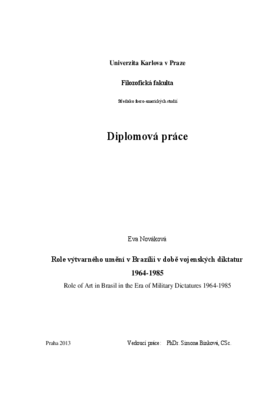Role výtvarného umění v Brazílii v době vojenských diktatur 1964-1985
Rorle of Art in Brasil in the Era of Military Dictatures 1964-1985
diplomová práce (OBHÁJENO)

Zobrazit/
Trvalý odkaz
http://hdl.handle.net/20.500.11956/54814Identifikátory
SIS: 108790
Katalog UK: 990016251770106986
Kolekce
- Kvalifikační práce [24991]
Autor
Vedoucí práce
Oponent práce
Opatrný, Josef
Fakulta / součást
Filozofická fakulta
Obor
Iberoamerikanistika
Katedra / ústav / klinika
Středisko ibero-amerických studií
Datum obhajoby
10. 9. 2013
Nakladatel
Univerzita Karlova, Filozofická fakultaJazyk
Čeština
Známka
Velmi dobře
Klíčová slova (česky)
brazilská moderní historie, brazilské umění, brazilská umělecká hnutí, moderní umění, výtvarné umění, vojenský režim, cenzura, umělci proti diktatuřeKlíčová slova (anglicky)
Brazilian modern history, Brazilian Art, Brazilian artistic movements, modern art, plastic arts and painting, military rule, censorship, artists against dictatorship(česky) Diplomová práce se věnuje době brazilských vojenských diktatur v letech 1964 až 1985 a působení výtvarných umělců během těchto let. V první kapitole je nastíněn historický vývoj vedoucí k nástupu vojenské diktatury a následně doba vojenské vlády až po její pád v roce 1985 a návrat k demokracii. Ve druhé kapitole je stručný přehled vývoje brazilského umění ve 20. století až do vojenského puce v roce 1964. Poté se práce zaměřuje na výtvarné umění v letech 1964 až 1985. Součástí textu je popis jednotlivých období ve spojení s mírou cenzury a restrikcí. Dále jsou představeni přední protirežimní umělci a jejich tvorba na nejdůležitějších výstavách a manifestacích. Pro lepší ilustraci působení umělců za diktatury jsou dvě samostatné kapitoly věnovány významným protirežimním umělcům Arturu Barriovi a Cildu Meirelesovi.V závěru jsou shrnuty poznatky.
(in English): This thesis is devoted to the time of the Brazilian military dictatorship from 1964 to 1985 and effects of artists during these years. The first chapter outlines the historical development leading to the onset of military dictatorship and the subsequent period of military rule until its fall in 1985 and the return to democracy. The second chapter is a brief overview of the development of Brazilian art in the 20th century until the military coup. Then this thesis is focused on the visual arts from 1964 to 1985 and the text describes each part of the military dictatorship and the rate of censorship and restrictions. Further text describes the front anti-regime artists and their work at major exhibitions and demonstrations. For better illustration of the effects of artists during the military dictatorship there are two separate chapters devoted Artur Barrio and Cildo Meireles, two significant anti-regime artists. The conclusion summarizes the findings.
